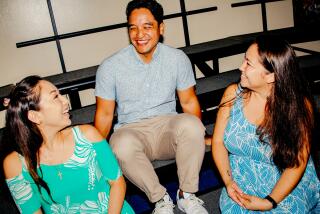â1,000 Paper Cranes So the Gods Can Make You Well Againâ
With squares of colored paper and nimble fingers, a classroom of fifth-graders is learning--and teaching--a lesson of compassion and hope, literally a thousand times over.
It all began with a book.
The students in Room 27 at Hoover Street Elementary School had just finished reading âSadako and the Thousand Paper Cranes,â a poignant novel about a young girl from Hiroshima who developed leukemia, the âatom bomb sickness,â a few years after World War II.
The book by Eleanor Coerr is based on a true story and tells how 9-year-old Sadako began folding 1,000 origami cranes--symbols of long life and good luck--from her hospital bed. She set to work after her best friend, Chizuko, made her a crane of golden paper.
Donât you remember that old story about the crane?
Itâs supposed to live for a thousand years. If a sick person folds one thousand paper cranes, the gods will grant her wish and make her well. Hereâs your first one.
Teacher Steve Heermann says that for many of his students, the book evoked memories of their own family tragedies. Nearly all Latino, they are immigrants or the children of immigrants, scratching out lives on the edge of the Pico-Union District, not far from stores burned in the riots.
âFifty percent of them usually donât make it out of high school,â Heermann says. âThis is a tough area.â
But some things, such as goodwill and love, can be even tougher. That was clear last month when Heermann told his students that, coincidentally, one of his wifeâs cousins suffers from leukemia.
Thatâs when Rodrigo Flores spoke up.
âWhy donât we do the cranes?â
Heermann hesitated at first. It couldnât be considered schoolwork, he knew, and, besides, âI didnât even know how to fold cranes.â
As Heermann and his students discussed the book, Kari Vanegas cut a piece of paper into a square and after about 24 folds held up a graceful crane. She had learned origami in third grade, during a lesson on world cultures.
And so it began. Art had imitated life, and now life was imitating art. Sadako was Japanese; the cousin is Japanese-American. Both gestures of friendship were spontaneous.
With Heermannâs mother-in-law providing the origami paper, the 29 students soon began filling two cardboard boxes with all kinds of cranes--gold and silver, red and yellow, blue and green. Some wrote get-well cards and folded them into cranes. All signed a letter:
We all wanted to send you a 1000 paper cranes so the gods can make you well again.
The students told friends about their mission, and they began making cranes, too. When Christian Aquinoâs father asked why the boy was folding colored paper, he told the story of Sadako and his teacherâs relative. Soon the father was folding.
âHe helped me do it,â Christian says, smiling. âI teached him!â
On a recent afternoon, the students repeated what had become a familiar scene in Room 27. As the school day ended, the students rushed Heermann, holding out their hands as they asked for origami paper.
âHow many?â he asked.
âFive,â Flor Barrios answered, taking the paper.
âDo your homework first, though.â
Others asked for 10 sheets, some five. Kari wanted 17.
In little more than a week, the students had their thousand cranes, including a large golden one, just like Sadakoâs, inserted into a copy of the book for the stricken woman. Heermannâs mother-in-law would later string them together for hanging.
Why all this for someone they had never even met?
âBecause we love her and want to save her life,â said Flor.
âSo she could get better,â offered Evelyn Herrarte.
âShe could believe that everybody loved her,â explained Rainer Farfan.
Said Jose Pineda: âSo she could think that weâre part of her.â
In the book, and in real life, Sadako died. She made 644 cranes, and they were strung above her hospital bed. The bookâs epilogue summed it up: âHer classmates folded 356 cranes so that one thousand were buried with Sadako. In a way she got her wish. She will live on in the hearts of people for a long time.â
So will the recipient of these cranes--and the students of Room 27.
More to Read
Sign up for our Book Club newsletter
Get the latest news, events and more from the Los Angeles Times Book Club, and help us get L.A. reading and talking.
You may occasionally receive promotional content from the Los Angeles Times.






